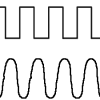 The Foundational Questions Institute (FQXi) has a thought-provoking new essay challenge for seasoned physicists, cosmologists, and lay-persons to answer: “Is Reality is Digital or Analog?”
The Foundational Questions Institute (FQXi) has a thought-provoking new essay challenge for seasoned physicists, cosmologists, and lay-persons to answer: “Is Reality is Digital or Analog?”
In one sense, analog and digital is not an either/or question but two points on a continuum. Analog and digital are different information compression algorithms, using frequency and amplitude as levers for modulating information onto electromagnetic spectrum. As analog has progressed to digital, so too could there be several subsequent phases of information compression algorithms that are denser than digital.
Along the electromagnetic spectrum (Figure 1), analog communication uses radio waves, analog and digital satellite communication uses microwave frequencies, and digital communication uses fiber optics in the visible spectrum. Next-gen terahertz communications systems are already under development.

Quantum computing modulates atoms with information. Eventually, maybe all atomic and energy quanta could be modulated with information (smart matter). In the farther future, modulating information onto the other three forces (strong, weak, and gravitational) could be explored, along with the modulation of dark energy and dark matter. Gadget of the future: dark energy multiplexer.














 Email me
Email me Twitter
Twitter MS Futures Group
MS Futures Group Data Visualization Wiki
Data Visualization Wiki Economic Fallacies
Economic Fallacies
